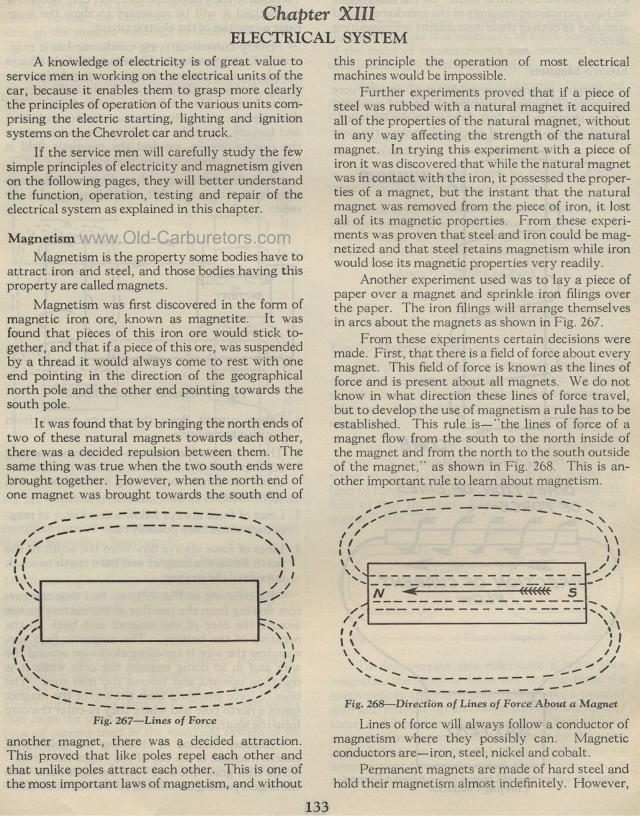1935 Chevy ELECTRICAL SYSTEM
A knowledge of electricity is of great value to service men in
working on the electrical units of the car, because it enables
them to grasp more clearly the principles of operation of the
various units comprising the electric starting, lighting and
ignition systems on the Chevrolet car and truck.
If the service men will carefully study the few simple principles
of electricity and magnetism given on the following pages, they
will better understand the function, operation, testing and repair
of the electrical system as explained in this chapter.
Magnetism
Magnetism is the property some bodies have to attract iron and
steel, and those bodies having this property are called magnets.
Magnetism was first discovered in the form of magnetic iron ore,
known as magnetite. It was found that pieces of this iron ore would
stick together, and that if a piece of this ore, was suspended
by a thread it would always come to rest with one end pointing
in the direction of the geographical north pole and the other end
pointing towards the south pole.
It was found that by bringing the north ends of two of these natural
magnets towards each other, there was a decided repulsion between
them. The same thing was true when the two south ends were brought
together. However, when the north end of one magnet was brought
towards the south end of Fig. 267— Lines of Force
another magnet, there was a decided attraction. This proved that
like poles repel each other and that unlike poles attract each
other. This is one of the most important laws of magnetism, and
without
this principle the operation of most electrical machines would
be impossible.
Further experiments proved that if a piece of steel was rubbed
with a natural magnet it acquired all of the properties of the
natural magnet, without in any way affecting the strength of the
natural magnet. In trying this experiment with a piece of iron
it was discovered that while the natural magnet was in contact
with the iron, it possessed the proper-ties of a magnet, but the
instant that the natural magnet was removed from the piece of iron,
it lost all of its magnetic properties. From these experiments
was proven that steel and iron could be magnetized and that steel
retains magnetism while iron would lose its magnetic properties
very readily.
Another experiment used was to lay a piece of paper over a magnet
and sprinkle iron filings over the paper. The iron filings will
arrange themselves in arcs about the magnets as shown in Fig. 267.
From these experiments certain decisions were made. First, that
there is a field of force about every magnet. This field of force
is known as the lines of force and is present about all magnets.
We do not know in what direction these lines of force travel, but
to develop the use of magnetism a rule has to be established. This
rule is—"the lines of force of a magnet flow from the
south to the north inside of the magnet and from the north to the
south outside of the magnet," as shown in Fig. 268. This is
an-other important rule to learn about magnetism.
Fig. 268— Direction of Lines of Force About a Magnet
Lines of force will always follow a conductor of magnetism where
they possibly can. Magnetic conductors are— iron, steel,
nickel and cobalt.
Permanent magnets are made of hard steel and hold their magnetism
almost indefinitely. However,

|
